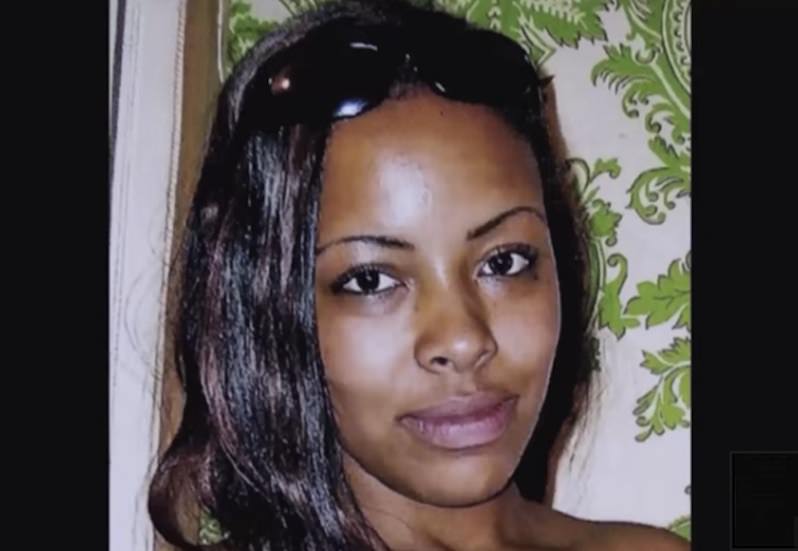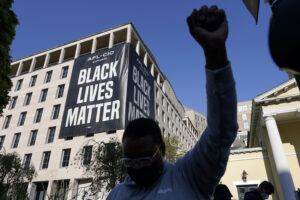Black Women’s Lives Matter: Film Reveals Little-Known Story of the Grim Sleeper
As an invigorated movement emerges against police killings of black men, a timely new documentary examines American law enforcement's negligence in the grisly killings of black women for over two and a half decades. "Tales of the Grim Sleeper" trailer image from YouTube
"Tales of the Grim Sleeper" trailer image from YouTube
“Tales of the Grim Sleeper” trailer image from YouTube
As an invigorated movement emerges against police killings of black men, a timely new documentary examines American law enforcement’s negligence in the grisly killings of black women for over two and a half decades. The HBO documentary “Tales of the Grim Sleeper,” by filmmaker Nick Broomfield, delves deep into the story of a man who is allegedly responsible for the murders of African-American women in South Los Angeles.
That man, named Lonnie Franklin Jr., was arrested by the Los Angeles Police Department four years ago, and as his pretrial hearing continues at a snail’s pace, Broomfield’s film successfully attempts to indict him for killing untold numbers of poor black women. Importantly, the film also shines a spotlight on the LAPD, and city- and state-level authorities (such as former LAPD Chief William Bratton who now heads the NYPD, and California’s then-Attorney General Jerry Brown, who is now the state’s governor), for condoning the killings through a reluctance to investigate or even educate the public that a murderer was on the loose.
Los Angeles in the 1980s and ’90s was an epicenter of violence and drugs, and the worst impacted part of the city was South L.A. The majority of residents were unaware of the spate of murders of mostly young black women that took place around a particular set of city blocks, or that those murders went unsolved for decades. The victims were aged 14 to 36, and some of them, but not all, were sex workers. The murderer was dubbed by journalists following the story as the “Grim Sleeper” because it was thought that he took a break from killing for more than a decade before starting up again in 2002. It is possible that there was no such break, however, given that the bodies of many missing women were simply never found.
Franklin has been charged in connection with the killings of only 10 women. But in “Tales of the Grim Sleeper,” Broomfield narrates that it is thought he killed more than 100 women over a 25-year period. One of the latest victims of the Grim Sleeper was 25-year-old Janecia Peters, whose lifeless body was found in a dumpster on New Year’s Day 2007. As reporter Christine Pelisek, who has closely followed the story, summarized, “Most of the victims were shot with a .25 caliber pistol, and their bodies were found along Western Avenue in South Los Angeles, discarded like trash. Most had been sexually assaulted.”
Franklin owned a .25 mm gun and lived right in the area where the women were turning up dead. He worked as a mechanic for the LAPD and a sanitation worker for the city of L.A. Franklin was arrested after DNA from his son linked him to saliva and semen found on the bodies of victims. Police found thousands of photographs of hundreds of women in his home, among them images of Janecia Peters and several other women who were found dead or are still missing. Franklin was well known in the local community. He dealt in stolen cars and had a number of male friends who had serious inklings about his interest in luring desperate women to his home and garage. The question that looms large is: Why did it take police so long to find Franklin and arrest him?
When I watched “Tales of the Grim Sleeper” ahead of an interview with the filmmaker and a concerned activist, I immediately imagined the manhunt that would have ensued had the victims hailed from a different part of the city, with higher incomes and lighter skin tones. It is a sentiment that arises time and again. As one L.A. Times reader commented, “it’s sad that so many black woman [sic] had to dye [sic] before the system finally caught up with this coward. …Wonder if the effort would have been the same if the victims would have been white?” Margaret Prescod, founder of the Black Coalition Fighting Back Serial Murders, and host of “Sojourner Truth” on KPFK, Pacifica Radio, told me in an interview last week, “If it is one young, white West Virginia student that goes missing, it’s on the news every day. The whole world knows about it.” Prescod has led the community response to the murders since the 1980s, the decade they first began. She and other female activists in Los Angeles have been on the front lines, asking law enforcement tough questions about why the murders remained unsolved for so long.
Around the same time as the murders started in the 1980s, the crack cocaine explosion in L.A. took off in a story that deeply implicates the CIA, as investigative journalists have revealed. High rates of drug addiction in South L.A. enabled someone like Franklin to prey on young women, as his friends narrate to Broomfield on film. It left significant numbers of the city’s residents unemployed, often as a result of felony convictions on drug-related charges. Many jobless South L.A. residents turned to the underground economy, which Franklin centrally figured in.
Prescod is convinced that the cocaine explosion and the murders are connected, saying, “We see a community that’s been devastated. We see very high unemployment rates, we see very little for young people to even do…. We see the safety net shredded where single mothers can no longer get any access to resources.” She lamented that the Grim Sleeper victimized members of what she called a “throwaway population … a community with so few resources, that most people would like to forget about.” Perhaps nothing symbolizes the dehumanization of the victims by police better than the term the LAPD had used to describe some of the murders — NHI, which stands for No Human Involved — a label for cases where sex workers or drug addicts were involved. Many of the Grim Sleeper’s victims were both. In “Tales of the Grim Sleeper,” Broomfield points his cameras at a number of Franklin’s male friends, who relate in intimate detail the way in which they allege Franklin would pick women up, lure them to his garage, photograph them in incriminating positions, have sex with them, and sometimes rape or torture them. Although none admitted knowing that he might have murdered them, it is shocking that many of them have yet to be interviewed by police. Broomfield thinks there should be an internal investigation into the LAPD’s inaction, telling me, “There really should be some kind of massive inquiry. It’s such a disgrace.”
Broomfield also prominently featured several women in the film, among them Laverne Peters, Janecia’s mother, whose tearful description about how much she misses her daughter reminds us of the tragic human cost of the macabre events: “This is my baby girl,” she told Broomfield, showing a photo of her daughter. “The love of my life. I don’t think the pain of losing a child ever really goes away.”
Also featured is Pam Brooks, a woman who claims she might well have ended up as one of Franklin’s victims had she not been lucky. Brooks was invaluable in introducing Broomfield to many members of the South L.A. community where Franklin allegedly operated. In a testament to how poverty can devastate people’s lives, Broomfield speculated about Brooks’ intelligence, “I’m sure if Pam had been born in a different part of the city, she would probably be running a corporation by now. As it is, she has a problem making the rent at the end of every month.”
Incredibly Broomfield, with Brooks’ help, spoke with several women who had been sexually involved with Franklin, including one who had survived an attempted murder. Police think Enietra Washington was the Grim Sleeper’s sole surviving victim. In 1988 she was picked up by a man she says was Franklin, shot in the chest, raped and then pushed out of his car. Remarkably she survived and even pointed police to a house just two doors down from Franklin’s. She described his face to police, and even related his unusually colored car — an orange Ford Pinto. The bullets dug out of her chest were determined to be from the same gun as the ones used on at least eight other South L.A. women — a .25 mm, just like the one Franklin owned. But it was only 20 years after Washington’s attempted murder that this information was even made public and 22 years later that Franklin was arrested.
With Brooks’ help, Broomfield found several other women who had similar experiences to Washington, and are said to have managed to escape Franklin — women whom the police have yet to identify and interview. Some are those whose photos are among the ones that Franklin took and the police later confiscated.
Again and again, the question arises: Why did it take police so long to identify and arrest a suspect? There is one hint in the film of what may have driven the LAPD’s inaction. Broomfield managed to persuade Franklin’s son Christopher to give an interview, and said in the film that Christopher boasted his father “had a lot of fans in law enforcement who admired him for cleaning up the streets.”
Hundreds of poor African-American women were either killed or went missing over the course of two and a half decades in South L.A. but Franklin is being charged with the murders of only 10. Either he ought to be a suspect in many more murders, or there are other killers at large. In fact, new evidence has recently turned up the possibility of additional suspects. Meanwhile parents of victims are frustrated at the slow pace of the trial. The ease with which an independent filmmaker like Broomfield managed to find and interview key figures in the case whom law enforcement have simply not pursued is a testament to how this case continues to be one that authorities would rather sweep under the rug.
“Tales of the Grim Sleeper” is a powerful reminder that American society, law enforcement and the justice system are rigged against black men and women. When she founded the Black Coalition Fighting Back Serial Murders in the 1980s, Prescod related the group’s slogan, so reminiscent of today’s rallying cry: “every life matters, black women’s lives count.” She added, “It’s the kind of devaluation of the lives of black women that we connect very much with the mass movement that’s happening now in the streets about black lives matter.”
“Tales of the Grim Sleeper” will begin airing in April on HBO. There are select screenings in cities around the country this month. The film has been shortlisted for the Academy Awards’ best feature documentary.
Your support matters…Independent journalism is under threat and overshadowed by heavily funded mainstream media.
You can help level the playing field. Become a member.
Your tax-deductible contribution keeps us digging beneath the headlines to give you thought-provoking, investigative reporting and analysis that unearths what's really happening- without compromise.
Give today to support our courageous, independent journalists.






You need to be a supporter to comment.
There are currently no responses to this article.
Be the first to respond.